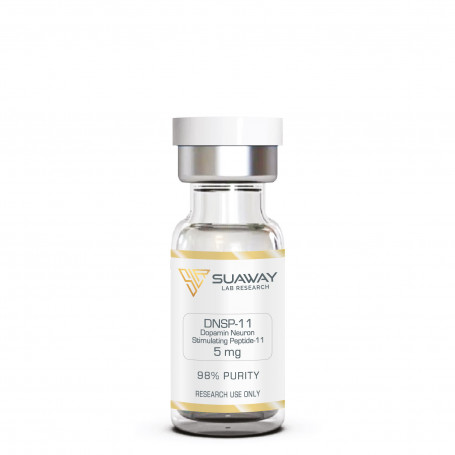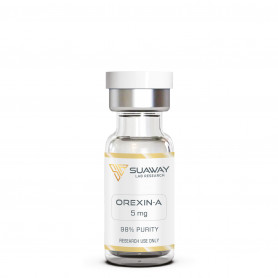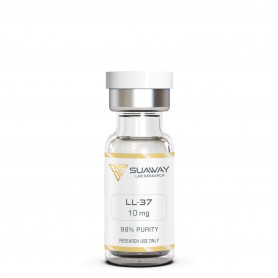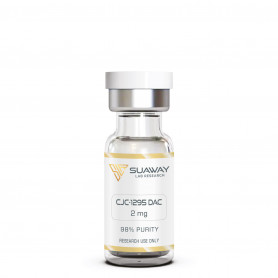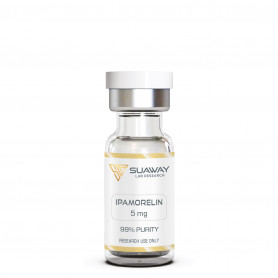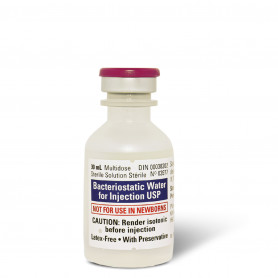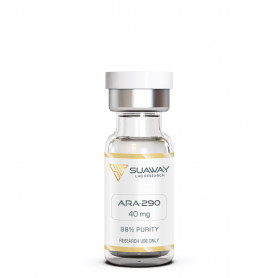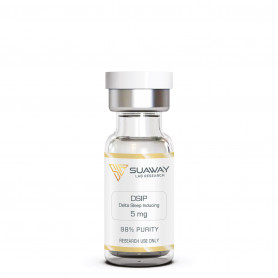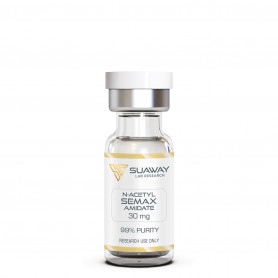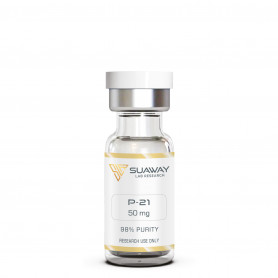Beschreibung
STRUCTURE
Sequence: PPEAPAEDRSL-NH2
Molecular Formula: C50H81N15O18 • xC2HF3O2
Molecular Weight: 1180,27 g/mol
Peptide Purity: Greater than 98%
Other details: No TFA Salt
Storage: Lyophilized peptide must be stored at -20°C and peptide solution at 4°C.
DNSP-11 has has low oral and excellent subcutaneous bioavailability.
DESCRITPION
The 2nd most frequent kind of severe neurodegenerative condition is Parkinson's disease (PD), sometimes known as the "tremor disease." Dopaminergic neurons in the substantia nigra pars compacta (SNpc) gradually degenerate, which is one of the defining characteristics of this condition. After the loss of sixty percent to eighty percent of the dopaminergic neurons in the SNpc, Parkinson's disease will first present clinically, and the first clinical symptoms will occur roughly five years after the illness initially appeared. Unfortunately, there is currently no cure for Parkinson's disease, and the available treatments can only alleviate the symptoms without halting the course of the illness or improving patients' quality of life. Dopamine (DA) levels may be increased by increasing the production of dopamine and/or lowering its metabolism. This can help restore motor impairments that are linked with nigrostriatal dysfunction. However, these medications are not able to repair injured DA neurons or improve their chances of survival.
Therefore, neuroprotection and neurorestoration could be an answer to the challenges that are presented by standard treatment for Parkinson's disease. The neurorestoration therapy's objective is to bring about a change in the patient's pathophysiological surroundings that will result in the restoration of the DA phenotype.
In animal models and in some clinical trials for Parkinson's disease (PD), the neurotrophic factor known as glial cell line-derived neurotrophic factor, or GDNF, along with other related neurotrophic factors, have demonstrated significant potential for the protection and restoration of dopamine neurons that have been damaged or are dying.
However, owing to the difficulties involved with transporting neurotrophic factors like GDNF to the CNS as well as the complexity of protein synthesis and structural alteration, smaller neurotrophic-like molecules that are easier to manufacture, change, and have enhanced bioavailability are required.
The neurobiological effects of a short peptide with 11 amino acid amidated peptide that was derived from the proGDNF domain and given the name dopamine neuron stimulating peptide-11 were described in a study (DNSP-11). Following a single injection of DNSP-11 into the substantia nigra of a normal adult rat, increases in resting dopamine levels and its metabolites were found in vivo 28 days after the injection. These rises were detected in the substantia nigra.
In addition, when tested in a severe model of Parkinson's disease using rats treated with 6-hydroxydopamine, DNSP-11 showed considerable improvement in apomorphine-induced rotating behaviour as well as a rise in dopamine and metabolite tissue levels in the substantia nigra.
In vitro studies have shown that DNSP-11 promotes the survival of primary foetal mesencephalic neurons as well as the development of neurites. DNSP-11 prevents cell death caused by staurosporine and 6-hydroxydopamine in the MN9D dopaminergic neuronal cell line. This is shown by a considerable reduction in levels of caspase-3 activity and TUNEL-positive cells.
In conclusion, DNSP-11 pull-down experiments show that additional anti-parkinsonian medicines may be targeting similar molecular mechanisms. These observations, taken together, provide credence to the hypothesis that the short peptide in question has neurotrophic-like properties; hence, it is a contender for future investigation as a possible Parkinson's disease treatment.
REFERENCES
J.L. Fuqua et al., "Dynamic Changes in Dopamine Neuron Function after DNSP-11 Treatment: Effects in vivo and Increased ERK 1/2 Phosphorylation in vitro" [PubMed]
J.W.H. Sonne "Effects of Intranasally Administered DNSP-11 on the Central Dopamine System of Normal and Parkinsonian Fischer 344 Rats" [ResearchGate]
Y.A. Sidorova et al., "Small Molecules and Peptides Targeting Glial Cell Line-Derived Neurotrophic Factor Receptors for the Treatment of Neurodegeneration" [MDPI]
L.H. Bradley "Dopamine Neuron Stimulating Actions of a GDNF Propeptide" [ESMO]
M.S. Parmar et al., "DNSP-11 reduces 6-OHDA-induced caspase 3/7 activation in an SH-SY5Y cell model: Potential Role of ERK signaling pathway?" [The FASEB Journal]
L.H. Bradley "The neuroprotective actions of dopamine neuron stimulating peptide-11" [Journal of Neurology & Neurophysiology]
M.J. Stenslik et al., "Methodology and effects of repeated intranasal delivery of DNSP-11 in a rat model of Parkinson’s disease" [PubMed]
K.A. Kelps et al., "Evaluation of the Physical and In Vitro Protective Activity of Three Synthetic Peptides Derived from the Pro- and Mature GDNF Sequence" [PubMed]
DISCLAIMER
This product is intendend for lab research and development use only. These studies are performed outside of the body. This product is not medicines or drugs and has not been approved by the FDA or EMA to prevent, treat or cure any medical condition, ailment or disease. Bodily introduction of any kind into humans or animals is strictly forbidden by law. This product should only be handled by licensed, qualified professionals.
All product information provided on this website is for informational and educational purposes only.

